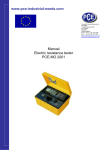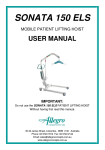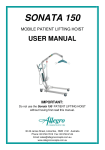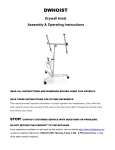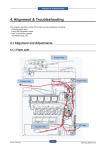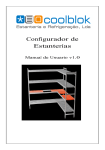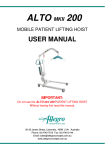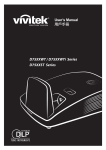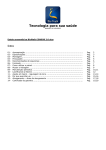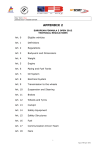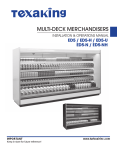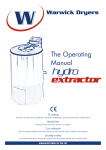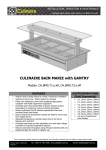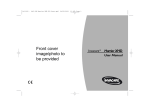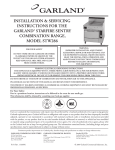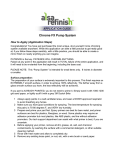Download Allegro Salsa Hoist
Transcript
SALSA MOBILE STANDING TRANSFER HOIST IMPORTANT: DO NOT USE THE SALSA STANDING TRANSFER LIFTER WITHOUT HAVING FIRST READ THIS MANUAL. CONTENTS SALSA LIFT 200 OVERVIEW 1 IMPORTANT SAFETY CONSIDERATIONS 2 SALSA LIFT 200 ASSEMBLY INSTRUCTIONS 3 HOIST OPERATION AND CHARGING 5 LIFTING PROCEDURES 8 MAINTENANCE 9 TROUBLE SHOOTING 10 SPECIFICATIONS 11 WARRANTY 12 LOG BOOK 13 OVERVIEW SALSA The SALSA mobile standing hoist is designed to assist the less than able person transfer from a seated position to a supported standing position. The SALSA whilst compact and manoeuvrable has a safe working load (SWL) of 200KG. This lifter is suited to both home or institutional use. The SALSA is an electric operated hoist with ergonomic features designed with the patient and carer in mind. An ALLEGRO standing sling specifically designed for the SALSA is available. This sling provides maximum support and comfort for the patient. The Allegro Concepts range of patient lifting equipment including lifters, slings and accessories has been designed and tested in house to comply with: AS ISO 10535 – 2002 Hoists for the transfer of disabled persons – Requirements and test methods. 1 IMPORTANT SAFETY CONSIDERATIONS INTENDED USE OF THE PRODUCT The SALSA compact mobile patient standing/transfer hoist has been designed to lift and transfer a less able person with the assistance of a carer. The SALSA should be used with one of the ALLEGRO range of patient slings, as assessed by a competent trained person. NB. Not all slings and accessories are compatible with this hoist. If you are unsure please contact ALLEGRO CONCEPTS. The correct and appropriate use of the SALSA hoist will reduce the risks associated with manual patient handling. The lifting/transferring task should be assessed & planned by a trained user. SAFETY CONSIDERATIONS Ensure all that all users read this guide before operating the hoist. Do not operate the hoist without training in the safe operation of hoists & slings. IF IN DOUBT DO NOT USE. Only use slings which have been assessed as suitable by a competent trained professional. Read the relevant sling users guide which is provided with each sling, before use. Do not use the hoist if there is any doubt about wear or damage to the unit. Do not use the hoist if there is any fraying or stitch damage to the sling or if the sling is damaged in any other way. DO NOT EXCEED THE SAFE WORKING LOAD OF THE HOIST. (SALSA 200KG) Ensure when the hoist is in use that the surrounding area is clear and the person being lifted is clear of all obstructing objects. THE SALSA STANDING TRANSFER HOIST IS NOT DESIGNED OR INTENDED TO USE WITH NON WEIGHT BEARING PATIENTS. 2 LIFT ARMS PUSH HANDLE ACTUATOR BATTERY PACK KNEE PAD LEG 3 ASSEMBLY INSTRUCTION S SALSA 200 All the ALLEGRO range of patient lifting and transfer hoists are fully assembled, load tested and certified at the factory before being partially dismantled for packing and shipping. Use the instructions below as a guide to assemble your SALSA standing hoist. 1. Remove lifter components from protective packing and lay out on a smooth surface to prevent damage to powder coating on lifter sub assemblies. 2. Remove mast/leg chassis weldment and slide one leg into receiver clevis. Align bolt holes, push bolt through clevis and leg bush. Thread nylock nut onto bolt on the under side of leg and tighten. Ensure thread engages nylon locking ring of nut. 3. Repeat process 2. for second leg. 4. Attach leg adjuster tie rod ends to each leg and tighten each nylock nut. 5. Attach lift actuator to lifting arm assembly by aligning actuator clevis with actuator mount bracket. Insert bolt and tighten nylock nut. 6. Attach push handle assembly with hex bolts and washers supplied with handle assembly. 7. Attach Linak control box to mount plate with M5 hex bolt, then attach clip on battery pack. 8. Plug the lift actuator cable into port 1 and the leg adjust cable into port 2 of the control box. Both ports are located on the underside of the control box. (diagram 1) 9. Ensure both plugs are pushed in firmly into their respective sockets. Diagram 1 10. Locate handset and push into handset socket ensuring alignment of tongue of plug with keyway of socket. Push home firmly. A smear of Vaseline on the O ring may assist if plug is tight Check operation of the SALSA via handset, ensuring that the RED EMERGENCY STOP BUTTON ON THE CONTROL BOX IS RELEASED. Turn the knob – turn clockwise to release. 4 HOIST OPERATION AND CHARGING HANDSET The handset activates the lift actuator by the use of two low pressure buttons, protected by a strong plastic cover. These are symbolised by arrows (diagram). The arrows indicate the direction of travel to raise or lower the hoist jib. When either button is released the jib will remain in position. Some versions of ALLEGRO hoists incorporate an actuator driven leg opening adjustment. On these hoists two extra buttons will be seen on the handset with arrows and symbolised legs indicating the direction of travel. This function allows an unrestricted range of leg adjustment. The handset is also fitted with a battery indicator light. This will flash when the batteries reach a maximum discharge of 18 volts. NB the light will only flash when the hoist is under load. The connection for the handset is located on the underside of the control box (diagram 1). HANDSET ACTUATOR RELEASE LEG ADJUST ACTUATOR The SALSA 200 mobile patient STANDING/TRANSFER hoist uses a LINAK single speed actuator with an emergency controlled lowering release handle.( red lift up tab located at base of actuator shaft). This allows the patient to be lowered in the event of a fault in the hoist or deep discharged batteries. 5 CHARGING The SALSA is suppled with a LINAK external wall mount charger. This is activated by plugging the 3 pin plug into a standard 240Vac outlet. To recharge the battery pack perform the following steps: • Release battery pack from control box by pulling the handle on the pack towards you.Use both hands to support the battery pack when removing or replacing it. • Clip the battery pack onto the charging unit ensuring it is seated properly on the charger base. • Charger will automatically activate charging sequence . CHARGING INDICATOR LIGHTS GREEN mains power on light will be illuminated when connected to 240 v power supply. ORANGE LIGHT illuminated indicates battery currently charging. ORANGE LIGHT will extinguish when battery pack is fully charged. LINAK CHARGER UNIT 240V INPUT SOCKET 6 CHARGING DOs & DON’Ts DO Do charge the battery whenever possible. This will extend the battery life. A large number of cycles can be obtained from operating on the batteries, but battery lifetime is reduced with frequent discharging. Do inspect all cables particularly the mains power cable on the charger for any damage; replace where necessary. Do stow the handset and if fitted with charger, the mains power cable when transporting the hoist. Do clean the actuators, control box, charger, battery and handset at regular intervals to remove dust and dirt. DON’T Don’t allow the batteries to fully discharge before connecting to charger.The batteries are a lead acid gel type that can be trickle charged continuously and have a high current discharge capacity. The batteries are not the nickel cadmium type and must not be periodically fully discharged. Battery life is greatly reduced by deep or complete discharging of the batteries. Longer lifetime is obtained by maintaining fully charged batteries. 7 LIFTING PROCEDURES • Carer should be fully conversant and trained in the use of lifter and sling. This will decrease patient apprehension and increase their co-operation and overall safety of the lifting process. • Where possible always pull the lifter for maximum safety and comfort. • Move the hoist slowly to avoid patient swing whilst standing. • The hoist should not be used on ramps with incline greater than 5 deg. • Never leave a patient in a sling unattended. • Ensure brakes of the chair, bed, trolley that the patient is being lifted from are locked. • The braking castors on the lifter should be off. This allows the lifter to create its own centre of gravity (C.G,) over the weight of the patient. N,B. This action may result in the lifter moving slightly during the initial phase of the lift. GENERAL LIFTING PROCEDURE The information supplied below is not intended to be construed as a training manual but as a general guide to lifting procedure only. • The SALSA hoist utilises a special type of padded sling designed to fit around the patients lower back .It utilises a restraint belt to help prevent the sling from slipping and riding up the patients back. the restraint belt is adjustable and fastens with either a buckle or a velcro flap around the chest area. • Key hole buckles on the sling clip onto the studs located on both lift arms of the hoist. • For detailed sling fitting instructions refer to COMFORT STANDING SLING USER MANUAL. • N.B. THIS SLING SHOULD ONLY BE USED WITH THE SALSA HOIST AND MAY NOT BE COMPATIBLE WITH OTHER PATIENT HOISTS. • Manoeuvre the hoist around the patient, adjusting the legs to fit around chair, wheel chair etc. If lifting from a bed ensure under bed clearance is sufficient to manoeuvre legs under the bed. • Lower the SALSA lift arms using the handset buttons until sling keyhole buckles can reach and easily engage the studs on the lift arms. to prevent possible injury ensure the lift arms do not come in contact with patients face or body. • Place keyhole buckles onto the correct stud on each lift arm and pull firmly to engae and lock. A slight resistance should be felt as the buckle moves to the lock position. • Use the handset to raise the hoist boom enough to take up the patients weight. At this point stop the lift .Check all sling attachments are secure and that the sling is positioned correctly. Check patient comfort .Lower and realign sling if necessary. 8 GENERAL MAINTENANCE To prolong the working life of the lifter and for trouble free operation it is recommended that periodic inspections should be performed routinely and as often as necessary. Periodic inspections should be performed by a person who is suitably qualified and well acquainted with the design, use and care of patient lifting hoists. If inspection reveals that the safety of the hoist is jeopardised in any way the hoist should be IMMEDIATELY WITHDRAWN FROM SERVICE, tagged as such and the owner notified. MAINTENANCE GUIDE & CHECK LIST • General visual inspection of lifter. • Check castors are tightly attached to legs. • Check castors run & swivel freely, remove any hair & fluff from axle. • Check castor brakes operate efficiently. • Over haul castors & pack with grease. • Inspect surfaces for scratches & chips • Clean surfacers with a neutral detergent, remove any adhesive tape with orange or eucalyptus oil. • Examine all moving parts and fasteners for wear and fatigue, lubricate and /or adjust as required. • NB leg pivot bushes incorporate a Teflon coated pivot bush which requires minimal lubrication . • Check tightness of bolt in leg bushes. • Check linkages are secure in leg adjuster ball joints. • Check all electrical components for correct operation. • Check battery charger operation. • Remove dirt & dust from actuator. • Wipe actuator shaft with oiled rag (DO NOT use WD40 or equivalent.) • Check mast to boom pivot point, remove bolts and lightly regrease bush and retighten, ensuring free movement at pivot. A MAJOR SERVICE SHOULD BE CARRIED OUT EVERY 12 MONTHS AS A MINIMUM REQUIREMENT. IMPORTANT: An annual load test to the safe working load(swl) is required for compliance with AS ISO 10535 − 2002 9 TROUBLE SHOOTING WARNING TROUBLE SHOOTING SHOULD ONLY BE CARRIED OUT BY ALLEGRO CONCEPTS AUTHORISED PERSONNEL FAMILIAR WITH BOTH USE, ELECTRICAL AND MECHANICAL FEATURES OF PATIENT LIFTING HOISTS. The following is a guideline only to general trouble shooting. Before carrying out any trouble shooting ensure that. Red emergency stop button is released. Maintenance procedures checked & followed. All cable connections are secure. Battery is fully charged. POSSIBLE FAULT ACTION Warning buzzer sounds within control box. Flat battery pack. Faulty battery pack. Recharge battery. Replace battery. Battery charger power indicator LED does not light up. No mains connection. Internal fuse blown. Battery chargers is defective. Plug into mains. Replace fuse. Repair replace charger. Actuator will not run and no relay click is heard from control box. Control box is defective. Handset defective. Replace control box. Actuator will not run via handset but control box relays click. Actuator plugs not fully pushed in to control box. Actuator defective. Control box defective. Push firmly into correct port. Replace actuator or control. Actuator cannot lift full load or runs slow. Batteries not charged/defective. Load too high for lifter. Actuator motor damaged. Charge/replace batteries. Replace actuator. No response from control box, no clicking of relays is heard. Emergency stop button engaged. Hoist battery completely flat. Blown fuse in battery pack. Faulty control box. Release. Charge battery. Replace/repair control box. Actuator works in one direction only. Handset defective. Control box defective. Replace handset. Repair/replace control box. 10 SALSA SPECIFICATIONS SWL 200KG BASE LENGTH 1050mm EXTERNAL BASE WIDTH 655mm INTERNAL BASE WIDTH CLOSED 585mm INTERNAL BASE WIDTH OPEN 1035mm ELECTRIC BASE WIDTH ADJ. UNDER BED CLEARANCE 125mm MIN. HEIGHT OF LIFT ARM 825mm MAX. HEIGHT OF LIFT ARM 1670mm MACHINE WEIGHT 48.2KG MINIMUM STORAGE HEIGHT 1200mm REMOVABLE FOOTPLATE 11 WARRANTY ALLEGRO CONCEPTS PTY LTD warrants its products to be free from defects in materials and workmanship under normal use and service and will within the period stated below, from the date of purchase, repair or replace without cost to the original customer, any part assembly or portion thereof which shall be returned to ALLEGRO CONCEPTS and from OUR inspection shows to be defective. Patient lifter including electronics 2 years Accessories on lifter 2 years Patient slings 1 year Weighing devices 1 year Batteries 3 months ALLEGRO CONCEPTS PTY LTD cannot be held responsible for any personal injury, damage to the hoist or damage to property as a result of the improper or unsafe use of the product. No warranty claim shall apply where the product or any part thereof has been modified, varied, altered or damaged either accidentally or through improper or negligent use No warranty claim shall apply where the hoist is repaired or serviced by any persons not accredited by the authorised distributor. Warranty does not extend to items or components which may require replacement due to normal wear and tear ( e.g. castors, mouldings and paint work ) for which ALLEGRO CONCEPTS nor its distributors can be held responsible. BATTERIES Batteries carry a limited warranty from the original manufacturer which is subject to a stringent wear and tear clause. Any battery faults due to defect in original manufacture will normally become apparent within the first two months of use. Any gradual deterioration in performance after this period is normally associated with fair wear and tear, misuse and accidental damage, and as such is not covered by the manufacturers warranty. 12 LOG BOOK SERVICE TYPE CONDITION REPORT DATE: INSPECTED BY: SIGNATURE: ACTION TAKEN SERVICE TYPE CONDITION REPORT DATE: INSPECTED BY: SIGNATURE: ACTION TAKEN 13 DISTRIBUTED BY:
















